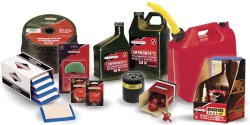Small Engine Maintenence Tips

The most crucial items necessary for a small engine to operate properly are:
Clean Air
Clean Fresh Fuel
Clean Oil filled to the proper level
Air Cleaner
A small engine will last much longer if you change your air filter often. If dirt and debris get past your air filter it will pass through your carburetor directly into the combustion chamber where the dirt and debris will damage the cylinder wall and piston rings, reducing the longevity of your engine. An air filter can also work just the opposite if it’s too dirty. A dirty air filter does not allow enough air into the carburetor in order to get the correct fuel/air mixture. The engine is essentially “choked” for air and it will draw more fuel than necessary eventually fouling the spark plug and causing a large amount of carbon buildup on top of the piston as well as the cylinder head, if it even starts at all!
Fresh Fuel
Fresh clean fuel is key to the longevity of any engine, whether in your mower or your car! Stale fuel will eventually turn into a green gummy varnish inside the carburetor. You can think of varnish as compared to clogged arteries in your heart. It forms on the walls of the tiny orifices and eventually closes into a plug in which no fuel will pass. If you use up or remove any fuel before storing, your engine will last much longer and will not require service.
Clean Oil
The oil in your small engine is just as important as the oil in your car. Oil serves two purposes, to lubricate moving parts and dissipate heat. Old oil contains carbon deposits, dirt, and microscopic metal particles. The oil protects the moving parts inside the engine from wear, heat build up, and corrosion. If your oil is old and black, it isn’t doing a very good job. Changing your oil regularly will ensure many years of dependable service from your engine.
Deck Maintenance
The most common reason people get rid of their lawnmower is because it has large rust
holes in the deck. This occurs when you use your lawnmower on wet grass which then gets
stuck to the underside of the deck. This trapped moisture does what it does best when
exposed to metals, it oxidizes! The same occurs when you leave your lawnmower outside during the winter months and exposed to rain and cold temperatures. Even if it doesn’t get directly rained on, the moisture outside can cause rust on any exposed portion of the mower deck as well as the cables and other moving parts. The best thing to do is to rinse off the underside of the mower after each mowing before you put it away. Wipe away any water that is left on the topside of the deck to prevent it from rusting. Wipe up any spilled oil or gasoline as the chemicals can eat away at the paint on the deck leaving exposed metal that can rust. There are many degreasers on the market that work great for this purpose. Spray these on your mower deck and on the engine block to keep it clean of dirt and grime (make sure not to spray water directly on or near the air filter and carburetor!)
Keep the Blade Sharp
The easier the blade goes through the grass, the easier it is on the engine. A sharp blade will also cut your grass more evenly without leaving the white tips on the grass.
Service the engine regularly
A properly serviced engine will last many years. There are a lot of 50 and 60 year old Briggs and Stratton engines still in service on many farms across America! They took care of their equipment and it still serves them well. Change the oil, air filter and fuel to keep a strong running dependable engine in service.
Keep Cables Lubricated
Many mowers are thrown away simply because the cables no longer operate. A small amount of oil or WD-40 will work wonders on a sticky cable. Keep it lubed up periodically and they won’t cause any problems.
Store Indoors When Possible
This is a key tip! When not in use, always store your mower indoors if possible, away from the elements. At a minimum, it needs to be under cover or covered with a tarp. The moisture, sunlight, heat and cold will do a tremendous amount of damage to a mower.
Two Stroke Equipment
It's critical to follow your manufacturers guidelines in reference to fuel/oil mixture. Many trimmers and chainsaws are destroyed when using the incorrect oil/fuel mixture. Download the following chart to ensure you're mixing your oil correctly.
| Two Stroke Premix Chart | |
| File Size: | 22 kb |
| File Type: | |
